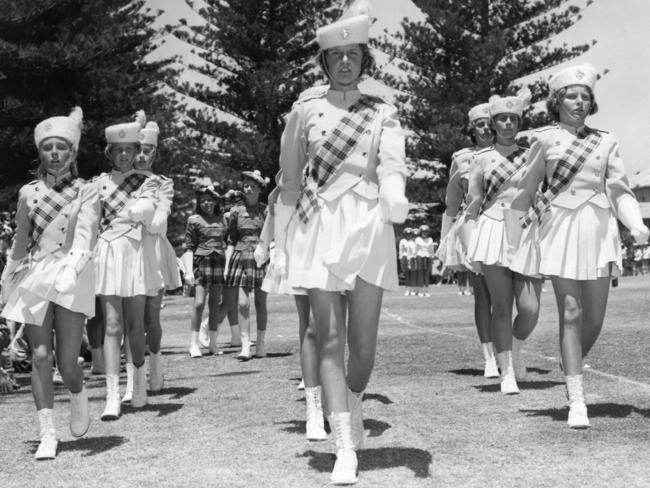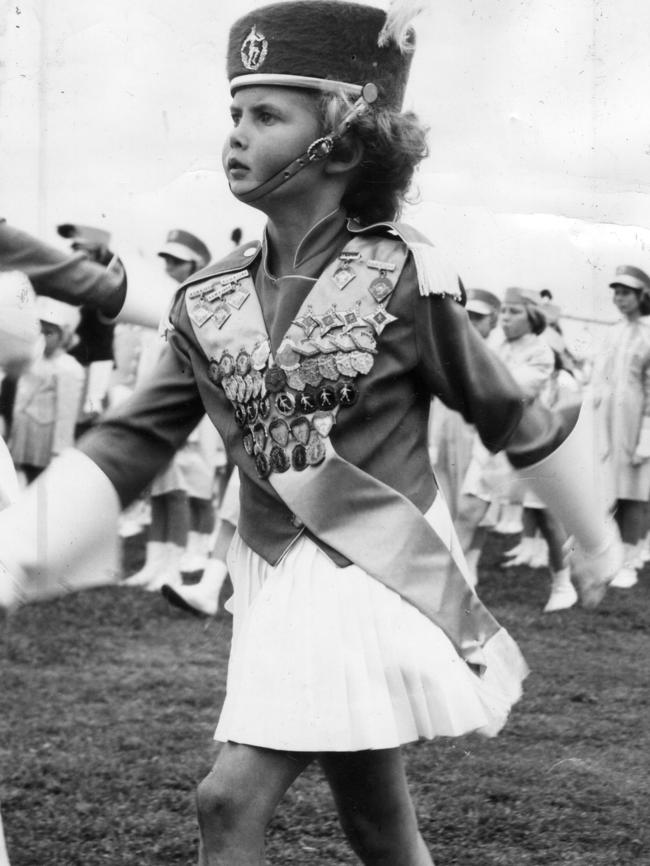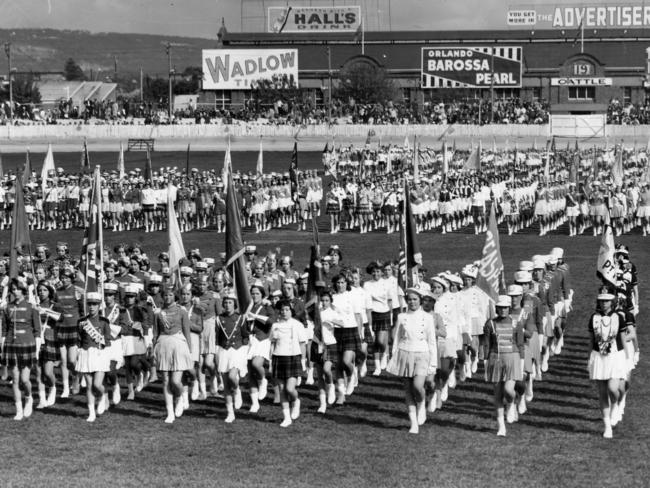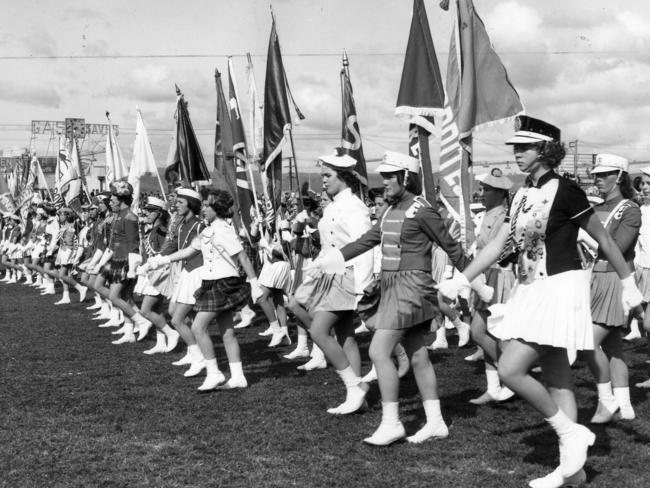Remember the era of marching girls and parades in Australia?
AUSSIE marching girls were all the rage back in the day — thousands competed every weekend in an era when everybody loved a parade. Here’s a look back.

SA News
Don't miss out on the headlines from SA News. Followed categories will be added to My News.
- Remember the giant Port Noarlunga sandhills?
- Bex: Australia’s cure-all that was addictive and damaging
- The Granite Island of SA’s past
- How KESAB advertising changed over the years
“EVERY weekend, thousands of girls in every state of Australia don jaunty caps, short skirts, and high white boots — and march.
They march through the streets, in parks and in playing fields. They march at football matches, carnivals, mardi gras, and fetes. A festive occasion in Australia isn’t complete without a team of marching girls these days.”
In June 1966, The Australian Women’s Weekly, the most popular women’s magazine in the nation at that time, devoted an eight-page spread and photo story to the marching girl phenomenon.
“There are nearly 30,000. They take their sport seriously, their uniforms can cost more than $50, and they have become a national institution. They are Australia’s marching girls.”


According to the story, the marching idea was brought to Australia from New Zealand in the late 1930s and became established in some smaller country towns before really catching on in the bigger cities in the early ’50s.
Other historical accounts suggest the marching craze started here during World War II when drill sergeants and officers in the Home Guard provided instructions in march formations to be used in keeping up workers’ morale and promoting physical fitness among young women.
These instructions also included “military forms adapted to a more ‘feminine’ style, brass and pipe bands provided the music”.

Whatever the beginnings, by the ’60s and ’70s, marching girls had become a national sport. Every weekend, thousands of girls turned out to compete for championship points, medals and trophies in local, state and national events.
Teams were asked regularly to join local celebrations, street parades, pastoral and agricultural shows, civic occasions, and even to welcome royal visitors.
The rules were simple. Teams consisted of up to a dozen members (sometimes more), plus a leader who issued commands with a whistle.


The aim was to move as one, displaying discipline and energy. It was seen as a physically active sport, challenging rather than strenuous, requiring skill and focus rather than sweat and muscle. There was no specialist equipment required for a team to start and membership often provided a real sense of belonging and a group environment.
Teams were responsible for designing their own uniforms and compared to the school gym costumes of the day, or netball and hockey outfits, the marching regalia was very attractive. It was designed to impress with sharp angles and straight lines to really catch the eye. Tartans, epaulets and lanyards adorned the uniforms with all manner of headgear including busbys, cockaded hats and Glengarry bonnets, finishing with gauntlets or gloves and long white boots that flashed in the sun.
There were Grenadiers and Cavaliers, Cadets and Guards, Kilties and Glennetes, the names selected by the teams were as colourful as their outfits.
The popularity of marching as a pastime and fun activity grew rapidly in the ’50s and by the ’60s had extended its reach to an even younger age group. Initially it attracted young women of a working age group but as time went on, schoolchildren began competing in junior competitions and by the late 1960s ‘midget’ marching girls could also be found contesting at the national championships.

In a recent post on the Australia Remember When Facebook page, hundreds of readers posted their memories of their years as a marching girl. “I personally would love to see the old format of Marching Girls make a comeback. It’s was fun and teamwork. Got to travel to lots of places and depending on how good your team was, you could even travel interstate. It was excellent exercise, gave your brain a good workout having to remember counting steps and movements. It instilled discipline, how to care for your uniforms — follow rules and regulations and be part of a club and association and a movement. Plus you learned the importance of fund raising, but most if all it was just having fun” wrote Carol Furphy.

Sue Swan remarked: “I marched with the Bankstown teams starting with the midgets, then went to the juniors (Vanguards) and also marched for the state demo team. At Bankstown we practised on the grounds next to Bankstown oval and also at the old Waltons car park for night practise. I remember going to the Australian championships in Melbourne and also Brisbane and being billeted out. After Bankstown I then went to a new team, Greenacre Lions (affiliated with the Lions Club). My father was the equipment officer, driving all over state in a VW Kombi Van which we kept in our backyard. I remember putting leg tan on every Saturday night and hoping it would not streak. I must say they were definitely the best days of my life”.
Other readers wrote “It was like having another family and lots of friends that you saw every Sunday after training all day on Saturday” or of vivid memories of cleaning white boots and preparing uniforms to be just perfect for the major titles.

By the late 1970s, marching had reached its height but like any sporting and recreational activity, it gradually began to lose appeal and popularity. Different weekend routines, competing recreational and leisure interests, changing career patterns and new and different opportunities for young women in sport, all took their toll and over the next decade, marching girls began to decline.
It still exists today in much smaller numbers and without the major championships, medals and honours.
But for those who took part and remember those halcyon days when marching girls strutted on the national stage it’s a memory they will keep forever.
Bob Byrne writes every day for the Adelaide Remember When blog at Adelaiderememberwhen.com.au and on the Adelaide Remember When Facebook page.


